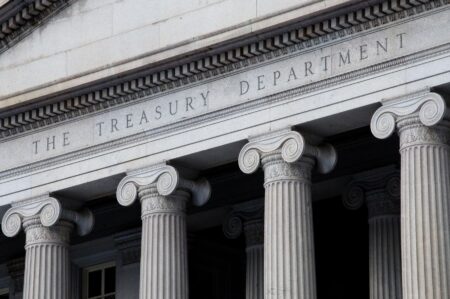If you’ve been following the news surrounding student loan forgiveness, you’ve likely seen the last minute push by the Biden Administration to get as many borrowers student loan forgiveness as legally possible.
While several loan forgiveness plans were ultimately squashed and the Saving On a Valuable Education (SAVE) plan is currently paused while its legality is decided in the courts, the Biden camp still accomplished the unthinkable by forgiving federal student loans for 5 million borrowers over a span of four years.
Some of this forgiveness was granted to students who were defrauded by their schools, whereas others had loans forgiven due to total or permanent disability or work in an eligible public service position.
A large portion of borrowers (over 1.4 million) also had their loans forgiven after the Dept. of Education pushed to fix administrative errors that were preventing forgiveness they were eligible for through income-driven repayment plans.
But could the Trump Administration upend this?
Can Trump “Undo” Past Student Loan Forgiveness?
Not surprisingly, many borrowers are worried things could change under the incoming Trump administration. After all, Trump has had a lot to say about student loan forgiveness plans over the last few years, and he even threatened to abolish the Department of Education completely during his most recent bid for the Presidency.
Trump’s proposals for student loans during his first term were also unfavorable for borrowers who want to have their loans forgiven. For example, Trump once proposed ending the Public Service Loan Forgiveness (PSLF) program completely, and he suggested consolidating all income-driven repayment plans to just one option that would require higher monthly payments of 12.5% of discretionary income instead of the 10% required by some existing plans.
With all signs pointing to Trump disliking the idea of student loan forgiveness, it’s normal to wonder if he has the power to “undo” forgiveness that has already taken place.
Fortunately, it seems incredibly unlikely that forgiven loans could be reinstated through any actions the President or his administration could take.
This means that, if you have had loans forgiven through PSLF, income-driven repayment plans, permanent or total disability, or having graduated from a school that cheated or defrauded you, you shouldn’t worry about having your forgiven loans thrust back on you once Trump is back in office.
It’s more likely that the Trump administration will simply abandon recent efforts to forgive more student loan debt, and potentially focus on changing up income-driven repayment plans in the future.
However, you should know that some borrowers who previously had their student loans forgiven due to administrative errors have seen their loan balances reinstated over the last year. These instances seem to be rare, but they still created panic for borrowers who believed their debt was gone only for their loan balances and payments to reappear in their lives.
What Do Trump’s Plans For Student Loans Look Like?
While borrowers who have already had their student loans rightfully forgiven can rest assured their student loans are done, anyone currently repaying student debt should be wondering what comes next.
This is true for borrowers with any type of federal student loans on any repayment plan, but especially for borrowers on the SAVE plan who don’t even know if they will be able to continue with that plan in 2025 and beyond. Fortunately, borrowers on the SAVE plan currently have their payments paused with no interest accruing while they await a decision from the courts.
For the most part, we’ll have to wait and see what Trump and his team are planning in the student loan realm in his second term. That’s because both the President and his nomination for head of the Department of Education (Linda McMahon) haven’t publicly stated any new plans for student loans quite yet.
Still, a quick look at suggested legislation from various conservative lawmakers can provide a bit of a “sneak peak” of what we might expect. For example, a bill from Rep. Mike Lawler (R-NY), called the Affordable Loans For Students Act would automatically reduce interest rates to 1% for new and existing federal student loans.
While this piece of legislation would lower monthly payments for many borrowers while helping reduce interest costs, it wouldn’t help borrowers who are repaying loans on existing income-driven plans (which is roughly half of borrowers) since these plans base monthly payments on factors like income and family size, not loan amount. This means the Affordable Loans For Students Act would help more borrowers with financial means than those who need the assistance the most.
Education and the Workforce Committee Chairwoman Virginia Foxx (R-NC) also suggested a bill in early 2024 called the College Cost Reduction Act, which would double the maximum Pell Grant for some borrowers while preventing interest from capitalizing on student loans. The bill would also eliminate the PLUS loan program for federal student loans, which has benefits but makes it far too easy for families to overborrow for higher education.
These are just some of the student loan ideas we have seen from Republican lawmakers, but they show us that conservatives are more likely to focus on changes to repayment plans instead of forgiving more loans.
What Should Borrowers Do Right Now?
If you have federal student loans and you’re worried about the future, all that’s left to do right now is wait and see.
While you await potential changes in the student loan landscape, including changes to available repayment plans, you should make sure you’re making at least the minimum monthly payment on your student loans on-time each month in order to avoid penalties and keep your loans in good standing and out of default. This is true regardless of the repayment plan you’re currently on, whether you’re repaying your loans on a 10-year repayment plan, repaying on an income-driven plan, or moving toward forgiveness of your loans through the PSLF program.
Depending on what happens in the coming years, it could make sense to repay loans on the standard 10-year repayment plan, or to opt for an existing or new income-driven repayment plan that is introduced after Trump takes the White House.
Read the full article here











